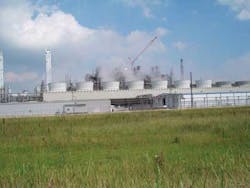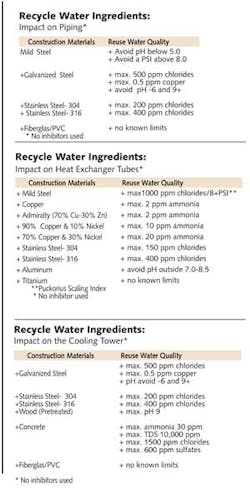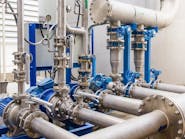By Paul R. Puckorius
Despite numerous facilities that have converted to recycled (municipal reclaimed) water from fresh water during the last 10 years for evaporative cooling water systems, there is still a question for anyone considering this change: Is it worth it? Those facilities considering a change include utility power plants, petroleum refineries, chemical plants, general manufacturing as well as HVAC (air conditioning). The trend continues today at increasing rates often due to the drought and other pressures.
Conversions have had many successes but also some failures. Those that have had good success did proper planning, gathered good knowledge of recycled water quality, along with water treatment chemical and non-chemical product performance, and implemented good water quality monitoring and control. They more often than not have saved 10-30% of costs over fresh water and more importantly obtained better protection of their water contacted equipment.
Before making any plans to convert an existing cooling tower water system to recycled water these questions need to be addressed:
1 What is the cost of recycled water versus fresh water?
2 Will the recycled water need further treatment to be acceptable? If so, what costs are involved?
3 What is the cost to bring the recycled water to the cooling tower water system from your "fence" line?
4 Will the water treatment cost of the cooling tower be increased or decreased with recycled water versus current and how much?
5 Are additional water monitoring or feed systems needed and what are their costs?
6 Can you expect equal, poorer, or better protection of the cooling water contacted equipment when on recycled water?
7 Is there any danger to using recycled water such as the potential for pathogens?
These questions can be answered usually by the recycled water provider, your water treatment supplier or an independent water treatment consultant. Once answered, they will certainly indicate if going to recycled water is desirable.
In answer to the above questions, typical examples of what have been obtained from numerous recycled water candidates:
1 Recycled water costs are usually 35-55% of the municipality's fresh water costs and likely will remain steady for several years. Fresh water costs are climbing each year. However a number of power plants, petroleum refineries, and chemical plants use fresh water from lakes, streams, and proprietary wells and only pay a pumping cost. In this case the recycled water costs were much higher, reducing the incentive to switch. One power plant using river water selected to blend the river water with recycled water 50/50 even though recycled water costs were higher. The driving force was fresh water conservation for crop irrigation.
2 If the recycled water is not of sufficient quality for your facility and must be treated further to be acceptable this cost must be identified. The municipality may provide the additional treatment or it may be done at the facility.
This issue occurred at a West Coast Refinery that identified that further treatment was essential for the local recycled water to be acceptable. The water contained over 10 ppm ammonia and could have caused cracking of the refinery's copper alloy Admiralty 70/30 copper/zinc heat exchanger tubes. The municipality elected to remove the ammonia from the recycled water to less than 1 ppm which was acceptable to the refinery. The additional treatment cost did raise the price of the recycled water but only 10-15%, making it still very worthwhile.
3 Cost of getting the recycled water to the cooling tower system varies for each facility. In a chemical plant or refinery it could mean a new line 100s or 1000s of feet from the fence line. In a HVAC building it means running a new pipe from the entrance to the cooling tower which may be on the top of the building.
One West Coast refinery decided to put in plain unlined mild steel pipe to move recycled water several thousand feet from the fence line. Plant operators found that the recycled water was so corrosive that it generated unacceptably high iron levels in the recycled water (3-5 ppm as Fe) before the cooling tower. Thus the cooling tower running at 5 cycles would potentially have 15-25 ppm iron which would foul the heat exchangers. The refinery was able to eliminate iron pickup by replacing the line with an internally lined mild steel pipe. That was a cost no one had identified originally.
4 The water treatment cost with recycled water generally is the same or lower versus fresh water. It can be lower due to the presence of 2-4 ppm phosphate in the recycled water which is a mild steel corrosion inhibitor. Any phosphate-based cooling water treatment might get most or all the phosphate needed. Also the presence of high chlorine in the recycled water (1-2 ppm free residual) often reduces the chlorine or oxidant at the facility. Even if ammonia is reduced to nitrates at 75-150 ppm, they also help reduce mild steel corrosion as well as stainless steel corrosion. Generally most facilities will see a water treatment cost reduction of 10-20% but this cost is very site specific.
5 Generally there is an increased need for monitoring and chemical feed systems, primarily to cope with any variation in recycled water quality or if blending of waters is occurring. This generally provides much better corrosion and deposit control in heat exchangers and chillers, depending on the amount of monitoring used for the existing fresh water versus the recycled water.
6 Protection of the cooling water equipment most often is equal to or better than with fresh water. This means longer life and less maintenance for the cooling water contacted equipment. This can be a big savings. The improvement can be attributed to several factors: perhaps the most important is that greater attention and control is exercised with recycled water versus fresh water. The increase in monitoring and chemical feed control also is a major factor in showing improved performance of the water treatment program.
7 Is there any additional danger from pathogens with recycled water versus fresh water as cooling tower makeup water? In all the cases we have been involved, several hundred, we have never seen concerns of possible pathogens, which were tested for. This is very likely due to the recycled water containing high levels of chlorine (1-3 ppm free residual). However it is always wise to run tests for total bacteria levels as well as for the presence of Legionella bacteria, the source of Legionnaires disease. Guidelines are less than 10 to the 4th ((10,00/cfu) for total bacteria per colony forming units and essentially zero for Legionella.
Other Considerations
Each existing facility with a cooling tower water system is unique and a plan of action is needed prior to switching to recycled water from fresh water for cooling tower makeup.
The first and initial knowledge needed is to determine the metallurgy of all water contacted equipment as well as their operating characteristics. This includes towers, piping, and all heat transfer units. Operators must also determine the maximum and average temperatures; the average and minimum water velocities; if there is any stagnant or redundant equipment; and the duration where no flow occurs. It is important to determine to what degree protection from corrosion, deposits, and biological was needed with fresh water. This will provide guidance as to what is needed with recycled water.
Different industries will have various designs and operating parameters that will require addressing certain recycled water ingredients more that other industries.
Some examples would include petroleum refineries, which often use mild steel (1010-1020) tubes and Admiralty brass (70% copper/30% zinc) tubes in their heat exchangers. The mild steel tubes require very good corrosion control but are susceptible to phosphate deposits and to copper plating. Excess phosphate and copper induced bimetallic corrosion can reduce life expectancy of the mild steel tubes. The Admiralty tubes must not see more than a couple parts of ammonia due to potential cracking.
Both HVAC and utility power plant cooling tower water systems generally use copper and Admiralty tubes in their chillers and condensers and must limit the ammonia in recycled water. HVAC systems often use galvanized steel cooling towers which can suffer from "white rust" due to copper plating as well as high or low pH of the cooling tower water. HVAC cooling water condensers often use enhanced (grooved) copper tubes that require improved copper protection.
The chemical industry uses stainless steel heat transfer surfaces and thus must limit the chlorides which can cause pitting and stress corrosion cracking.
Each industry has unique designs and operations that need to be identified and evaluated to prevent unexpected damage or reduced life expectancy resulting from various recycled water ingredients.
For existing cooling tower water systems, the facility can change out various water contacted equipment to handle the recycled water quality. However, this cost is very often undesirable. It can be more cost effective for the water provider to treat the recycled water to meet the desired quality.
Examples are the additional treatment to reduce phosphate by clarification and to eliminate ammonia via nitrification. Even partial conductivity reduction via membrane technology such as Reverse Osmosis (RO) is being done to provide better water quality not only for cooling tower systems but also boilers.
The second important consideration is to identify the key ingredients in the recycled water to determine if any will impact the cooling water contacted equipment in an adverse manner. Each cooling tower system needs to review their recycled water and their system for a more accurate determination of any adverse or beneficial impact.
Treatment Chemicals
There have been substantial advances in the performance of treatment chemicals and equipment introduced over the last several years. It is important to understand the increased capabilities, and limitations, of these products and systems. Most of the advances have been in deposit and microbiological control yet corrosion inhibitors have also improved. Examples are with new polymers for improved deposit control due to phosphate, iron, silica and hardness. Some are identified as "Quad", "HPS-1", "succinates". and "polyaspartate" just to mention a few.
One facility was able to use recycled water makeup with over 80 ppm phosphate in their cooling tower without any deposition. Another is carrying over 300 ppm silica with with no deposition.
Calcium hardness and other similar calcium scales are being treated with a combination of solubilizing and crystal modifying inhibitors that result in a non-scale deposit. Biocides have improved with chlorine dioxide now in liquid as well as pellets in addition to generation on site. Hydrogen peroxide is being used more frequently, just to mention a few.
Corrosion control has seen polysilicates and polysilicate plus polyphosphate blends for good mild steel protection with less phosphate deposits. Phosphate treatments are far better than earlier versions when used with specific newer polymers. Copper corrosion inhibitors are available that are more halogen resistant and even provide mild steel and aluminum corrosion control.
Membranes are being used to reduce all or some ions. High levels of ammonia can be removed by specific ion exchange or nitrification or by carrying higher cooling tower pH levels. The use of some non-chemical treatment systems show promise with some recycled waters for deposit and biological control.
Essentially any recycled water quality can be treated in the cooling tower water system to handle most corrosion, deposit, and microbiological problems with a combination of newer water treatment chemicals and specific control equipment.
Failures With Recycle Water
Why have there been failures in the use of recycled water as makeup to cooling tower water systems? Perhaps these several examples will illustrate some of the reasons:
One petroleum refinery was approached by a water supplier who offered recycled water containing 8 ppm of ammonia (as NH3). The refinery uses Admiralty (70% copper/30% zinc) tubes in their heat exchangers and knew that ammonia can cause catastrophic cracking to Admiralty tubes, possibly resulting in a fire or explosion. The recycled water supplier did not know this and refused to remove the ammonia. The facility has yet to consider the recycled water.
Another facility with large HVAC chiller tonnage failed to understand that their enhanced copper tubes required higher levels of copper corrosion inhibitor for good tube protection. Failure to know this resulted in tube failures and discontinuation of recycled water usage. Operators and the chemical supplier both blamed the "bad" recycled water. Several other HVAC users did the research and have been using recycle water successfully with similar equipment.
Still another facility did about everything right with good planning, established effective monitoring and control, modified their water treatment program correctly and found out that the recycled water at the cooling towers was exceptionally high in iron (over 5 ppm). At 5 cycles of cooling tower, the iron was 25 ppm and would have fouled heat exchangers. Additional water treatment to control the iron would be very costly. They investigated and found that water delivered to the plant perimeter had only 0.1 ppm iron. However, the recycled water had been nitrified and had a pH of 6.5 and a high free chlorine level (2 ppm). It was very corrosive to the mild steel pipe inside the plant, thus producing the high iron. The facility installed internally coated mild steel and the iron level remained at 0.1 ppm at the towers. The pipe designer should be working with the water treatment people.
Perhaps the most common failures in the use of recycled water has involved water treatment suppliers and end users who do not have experience with recycle water -- the water treatment program was not properly modified while the end user did not implement additional water monitoring and control. They often say it is "bad" water.
About the Author: Paul R. Puckorius is President and CEO of Puckorius & Associates (www.puckorius.com). He has over 50 years experience in cooling water, boiler water and reuse water technology, specializing in corrosion, scale and microbiological problem solving, treatment selection and system start-ups. He assists plants with system audits, cost reductions, vendor specifications, reuse considerations, zero blowdown via softening, hazardous chemical elimination, development of conservation programs and the optimum utilization of water and chemicals.



